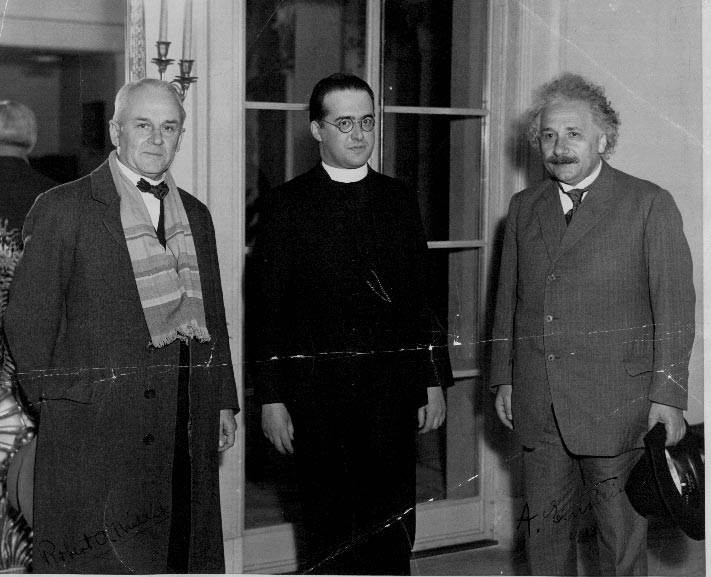
unknown photographer, Public domain, via Wikimedia Commons
If you grew up in the US, odds are that the story that you were told of how Big Bang theory was developed is missing a key figure – Catholic priest and astrophysicist Georges Lemaître. After Einstein published his theory of General Relativity in 1915 and wrote his cosmological constant paper in 1917, a graduate student named Georges Lemaître became fascinated with how the new theory might have tangible insights into the cosmos and the observations that were then being made. Famously, in 1927 Lemaître presented to Einstein his “primeval atom” paper which proposed that the universe began in a hot dense state. But Einstein dismissed the idea, committed as he was to the idea that the universe has been around looking more or less like its present state well into the distant past.
Last month it was my great pleasure to premiere the first planetarium show about Lemaître to a public audience at Ohio State University. Over 200 people got to see “Georges Lemaître and the Discovery of the Expanding Universe” which was adapted from a 1997 episode of Stephen Hawking’s Universe. My hope is that many more people get to see it as planetariums in other parts of the US share the show we developed, which is the next step for the project.
For me the premiere of the show was a moment that was years in the making. As an undergrad and grad student in InterVarsity, Lemaître was a kind of existence proof that being a person of faith and doing world class astrophysics was possible. Now as a professor, my interest in Lemaître is less so for my own encouragement and more from a place of wanting to share the story with young people who are trying to decide where they belong in a world of faith, science, and pseudoscience.
Although Dan Brown’s (highly fictional) DaVinci Code paints Lemaître as a kind of mystic who is obsessed with the origin of the universe, the reality is less flashy. Lemaître was a good scientist who had excellent math skills, good astronomy knowledge and in the early days when the theory of relativity was confusing even to experts he had a unique ability to see how the new theory might connect to observations. What makes him unusual was the simple fact of his life that he was equally priest and scientist. One week he would be at the Vatican serving on a committee for the Pope. Another week he would be at a physics conference or teaching a lecture still wearing his priest’s collar. His goal was not to proselytize his colleagues or to advance his personal theory for the origins of the universe. A saying by Thomas Merton, another Catholic thinker that I admire, is: “A tree gives glory to God by being a tree.” Lemaître gave glory to God, first and foremost, by being a great astrophysicist.
In most evangelical churches today, and most evangelical churches when I was growing up, it is (and was) not especially clear to young people that a career in science would be glorifying to God. It is not necessarily that anyone is actively discouraging young people to go into science, although probably in some cases that might be true. But there is definitely a subconscious message that gets communicated when the thing you would be studying – whether evolution or the Big Bang – is something that a non-negligible fraction of the congregation would take issue with. I hope in a small way that the planetarium show can push that needle by pointing out that a person of faith helped to develop the early ideas of Big Bang theory.
You can help bring the planetarium show “Georges Lemaître and the Discovery of the Expanding Universe” to planetariums across the US by donating at this link https://buckeyefunder.osu.edu/project/32975 As explained there, 100% of those funds will go to extend a licensing agreement with the BBC for an episode of Stephen Hawking’s Universe about Lemaitre that has been adapted by The Ohio State University for the planetarium format. Just $5 will extend the rights for one more day. Please also consider talking to the folks at your local planetarium about sharing the Lemaître show!
Prof. Chris Orban is a computational physicist and education researcher in the department of physics at Ohio State University. He earned his Ph.D. in physics at Ohio State in 2011 advised by Prof. David Weinberg on a project related to cosmological N-body simulations. Since then he has branched out into computational plasma physics (http://hedp.osu.edu) and education research (http://u.osu.edu/stemcoding http://buckeyevr.osu.edu). Orban also enjoys leading outreach projects and has served on a number of committees for the Ohio Department of Education

Leave a Reply